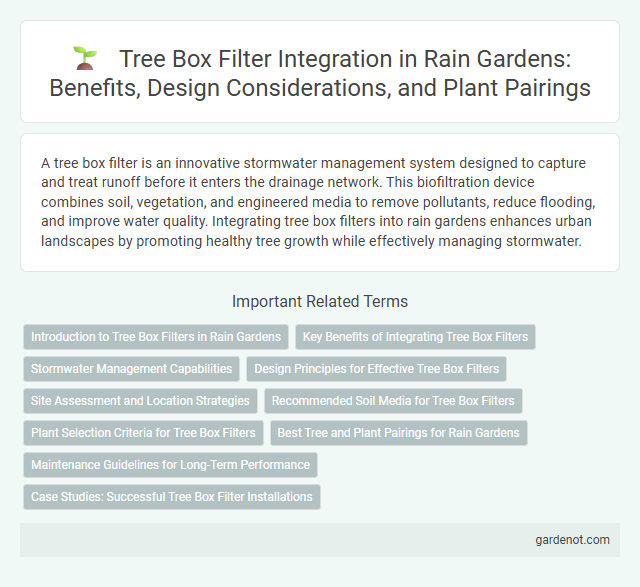A tree box filter is an innovative stormwater management system designed to capture and treat runoff before it enters the drainage network. This biofiltration device combines soil, vegetation, and engineered media to remove pollutants, reduce flooding, and improve water quality. Integrating tree box filters into rain gardens enhances urban landscapes by promoting healthy tree growth while effectively managing stormwater.
Introduction to Tree Box Filters in Rain Gardens
Tree box filters in rain gardens effectively manage stormwater by combining trees with engineered soil and filtration media to capture and treat runoff. These systems reduce pollutants such as sediments, heavy metals, and nutrients while promoting groundwater recharge and improving urban water quality. Integrating tree box filters enhances green infrastructure by supporting healthy tree growth and mitigating urban flooding.
Key Benefits of Integrating Tree Box Filters
Tree box filters enhance stormwater management by combining urban tree planting with advanced filtration systems that remove pollutants and reduce runoff volume. Integrating tree box filters improves water quality, supports urban biodiversity, and mitigates flooding risks by promoting soil infiltration and evapotranspiration. These systems contribute to healthier urban environments, reduce the burden on traditional drainage infrastructure, and enhance streetscape aesthetics.
Stormwater Management Capabilities
Tree box filters effectively enhance stormwater management by capturing and filtering runoff through engineered soil media and vegetation, reducing pollutants and sediment before water infiltrates or is discharged. These systems support groundwater recharge while mitigating urban flooding by slowing stormwater flow and increasing infiltration rates. Their ability to remove heavy metals, nutrients, and suspended solids contributes significantly to improving water quality in urban environments.
Design Principles for Effective Tree Box Filters
Tree box filters must incorporate engineered soil media that balances infiltration and pollutant removal to enhance stormwater treatment. Structural integrity is ensured by using durable frames and adequate load-bearing capacity while maintaining sufficient rooting space for tree health. Proper sizing and hydraulic design optimize flow-through rates, preventing clogging and promoting efficient water quality improvements.
Site Assessment and Location Strategies
Tree box filters require thorough site assessment to evaluate soil permeability, drainage patterns, and pollutant load for effective stormwater management. Ideal locations prioritize proximity to impervious surfaces such as roads and parking lots to intercept runoff before entering storm drains. Strategic placement considers space constraints, root growth potential, and accessibility for maintenance to maximize filtration efficiency and plant health.
Recommended Soil Media for Tree Box Filters
Recommended soil media for tree box filters typically consist of a well-draining mix combining sandy loam, compost, and organic matter to enhance nutrient retention and support healthy root growth. The medium should maintain optimal moisture levels while facilitating pollutant removal through physical, chemical, and biological processes. Properly balanced soil media promotes stormwater infiltration, reduces runoff, and sustains the long-term performance of rain gardens.
Plant Selection Criteria for Tree Box Filters
Plant selection criteria for tree box filters emphasize species with deep root systems and high tolerance to varying moisture levels to maximize pollutant uptake and stormwater infiltration. Native plants with robust growth habits, such as sedges, rushes, and certain grasses, enhance filtration efficiency while supporting local biodiversity. Selecting species resistant to urban pollutants and capable of thriving in compacted soils ensures long-term health and functionality of tree box filters in rain garden systems.
Best Tree and Plant Pairings for Rain Gardens
Tree box filters thrive with species like Bald Cypress and Red Maple, which effectively tolerate wet conditions and promote pollutant filtration. Pairing these trees with native plants such as Switchgrass and Blue Flag Iris enhances water absorption and provides habitat diversity. This combination optimizes the rain garden's ability to manage stormwater runoff while supporting local ecosystems.
Maintenance Guidelines for Long-Term Performance
Tree box filters require regular inspection and debris removal to maintain optimal stormwater filtration and prevent clogging. Periodic sediment and leaf accumulation cleaning, along with checking the health of vegetation, ensures sustained pollutant removal and water infiltration. Replenishing filter media and replacing damaged plants are essential for preserving the system's long-term functionality and environmental benefits.
Case Studies: Successful Tree Box Filter Installations
Tree box filters have demonstrated effective stormwater management in urban settings, as evidenced by successful installations in cities like Seattle and Portland, where they significantly reduced runoff pollutants while promoting groundwater recharge. Case studies reveal these bioretention systems consistently improve water quality by filtering heavy metals and sediments before they enter waterways. Their integration with existing urban infrastructure highlights their scalability and adaptability for mitigating urban flooding and enhancing green space aesthetics.
Tree box filter Infographic

 gardenot.com
gardenot.com